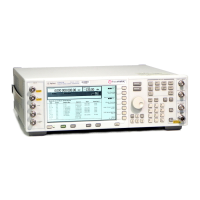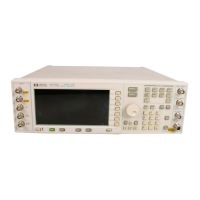538 Chapter 16
W-CDMA Uplink Digital Modulation for Receiver Test
Setting Up Compressed Mode for a Multiple TGPS Transmission
6. Set the frame offset for the first compressed frame so it does not overlap a compressed frame from
TGPSI 1.
a. Move the cursor to highlight the TGCFN field.
b. Press
1 > Enter.
The connection frame numbers (CFN) are a subset of the system frame numbers (SFN). Each value
denotes the start of a new frame with zero being the first frame position. To avoid compressed frame
overlapping, you must position the compressed frames for TGPSI 2 so they occur during normal
frame transmissions for TGPSI 1. Since TGPSI 1 starts at TGCFN 0 (frame position one) and has a
normal frame in the second frame position, TGPSI 2 will start its first compressed frame in the
second frame position (CFN one).
7. Set the duration for the transmission gap pattern, which is expressed as a number of frames.
a. Move the cursor to highlight the TGPL1 field.
b. Press
5 > Enter.
This value is the same as for TGPSI 1. This ensures that my frame alignment is consistent over time
and keeps frame overlapping from occurring between the two pattern sequences for the current setup.
This setting alone does not keep the proper alignment consistent, it is the combination of this setting
and the other spacing values that ensure proper compressed frame alignment.
8. Press the
TGPS Inactive Active softkey until Active is highlighted.
9. Press the
Apply Channel Setup softkey.
When the Apply Needed annunciator appears, press the
Apply Channel Setup softkey. The new settings
are not applied to the signal until this softkey is pressed.
Pressing this key disables the compressed mode trigger. Therefore, whenever this key is pressed while
transmitting in compressed mode, the compressed mode start trigger will have to be reapplied.
Figure 16-62 shows what the ESG display looks like when this step is completed.

